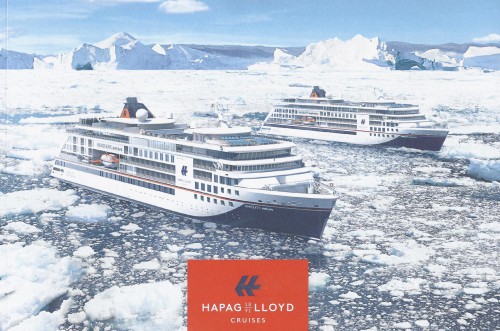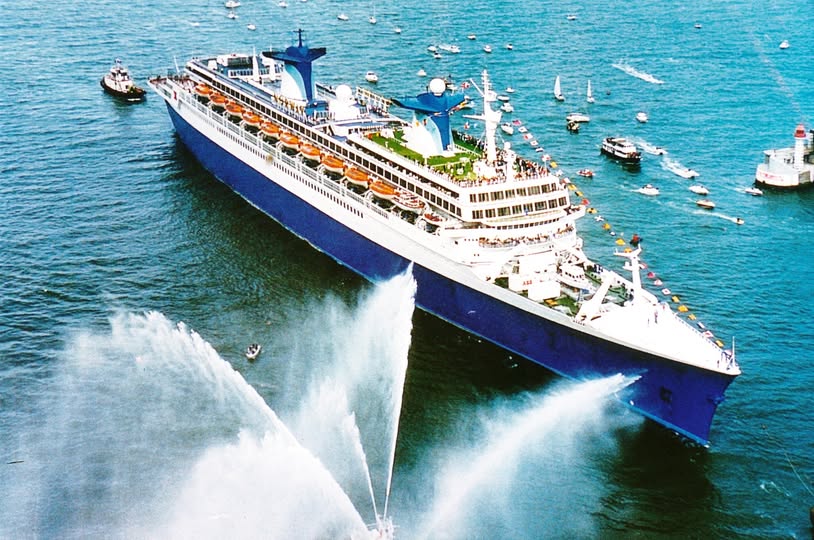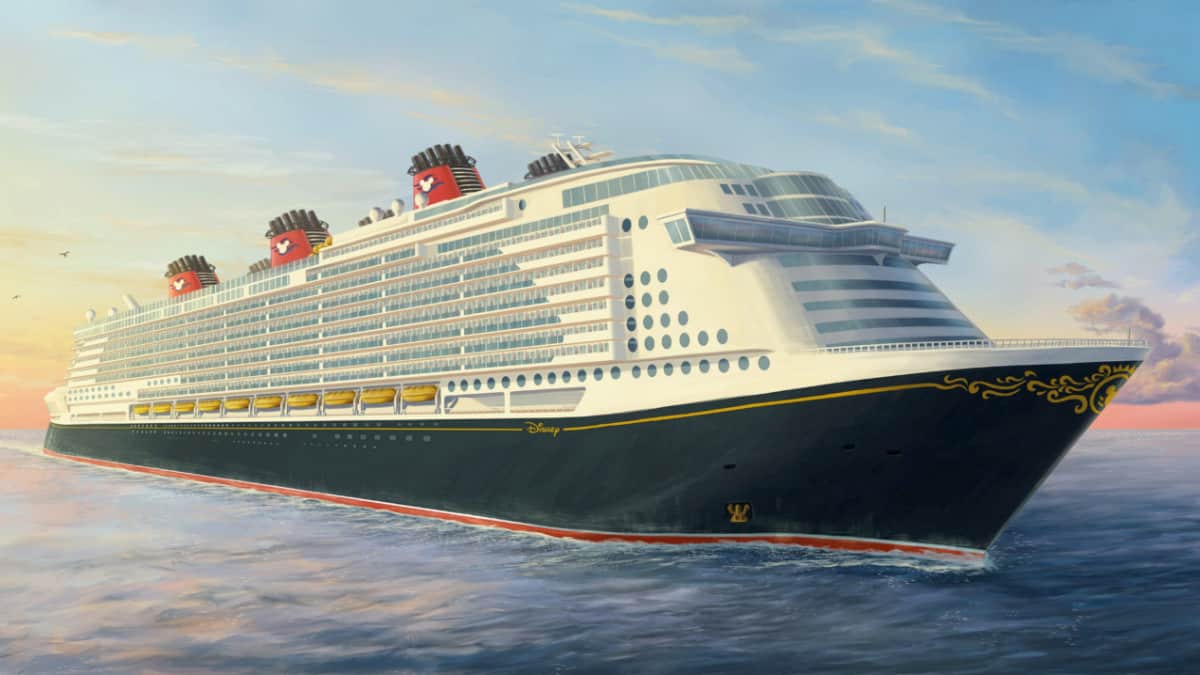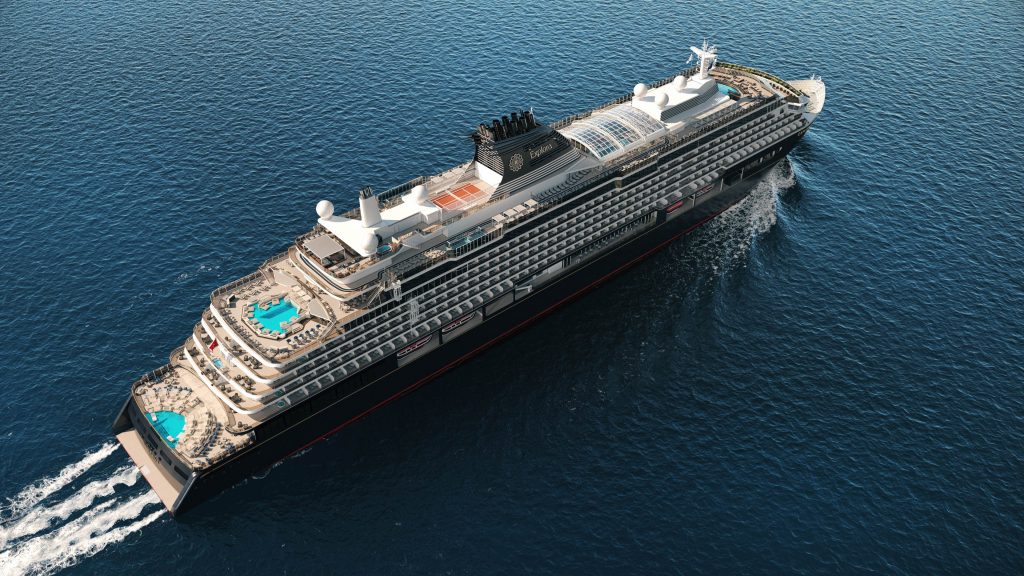One of the first cruises in history is said to have departed from Hamburg in 1891. It was the Auguste Viktoria which was on of HAPAG’s largest ships and mostly out of work during winter time as not many passengers wanted to experience the angry North Atlantic in winter time with its ferocious weather. So Albert Ballin, CEO of HAPAG organized a 58-day cruise to the Mediterranean and Orient which became a great success. Now, on May 4 2019, another passenger shipping milestone took place in Hamburg, as the first of HAPAG-Lloyd’s new trio of expedition ships was christened , Hanseatic Nature.
HAPAG’s Europa and Europa 2 have received the highest ratings possible for many years in a row now, and it is expected that the same will apply to their new expedition cruise ships. Karl Pojer, todays managing director of HAPAG-Lloyd Cruises stated in his speech during the naming ceremony of Hanseatic Nature, the first vessel of the series, that the company’s motto is “to let guests experience our great planet and enrich their mind”. This trio of expedition cruisers are cleared to sail to almost every remote region imaginable, as they are PC6-classified, meaning the highest ice-class for passenger ships.
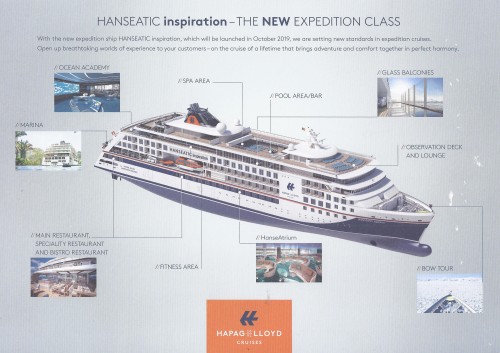
HAPAG will have several very experienced captains in command: Thilo Natke, Axel Engeldrum and Ulf Wolter who have all been in command of other ships of the company like the previous Hanseatic (until recently sailing as RCGS Resolute for now defunct One Ocean Expeditions) or the Europa 2. HAPAG has ordered all three ships from the Vard Group, A Fincantieri-subsidiary. Vard builds the 6500-ton hulls in their facility in Tulcea, Rumania and then they are towed through the Black Sea, The Mediterranean and along the coast of Western-Europe to Norway, a three and a half-week voyage to Norway, to the Vard Langsten-yard near Alesund, where the construction of the ships will be completed and they will be fitted out. Apart from Hanseatic Nature in May 2019 and Hanseatic Inspiration in October 2019, a third ship in this series, Hanseatic Spirit will follow summer 2020.

Compared to their Europa and Europa 2, these ships will not mainly be targeted to the German market, but they will have a more international clientele on board, hence the second language will be English. There are 120 staterooms and suites to be occupied by 230 passengers on “regular cruises” and only 199 guests during expedition voyages. Staterooms vary in size from 21 to 71 square metres, and their interiors have been done in bright colors as well as gray and white. Lights are activated by a motion sensor when guests enter the room.
Suite

The first of the 3 ships, Hanseatic Nature had originally been planned to be named in Hamburg on April 12 2019, but the Langsten yard experienced problems when finishing her, so the festivities were cancelled. Now delivery by the yard had been postponed to April 30 and Captain Notke sailed without passengers from Norway to Hamburg. The christening of Hanseatic Nature was changed to a more low-key one, as only crew and HAPAG staff was were present. Hanseatic Nature was named by Isolde Susset who was project-leader of the team building her and who has been involved in the HAPAG-Lloyd expedition cruise branch for 15 years as one of their key-employees.
The interior-design of the ships has been done by Oceanarchitects (Germany) following the main principle “Inspired by Nature”, meaning that the interior should connect with the outside world. So colors, material, fabrics as well as the use of flowing, curved lines in her interior (like the walls in staterooms and suites) and of course the artwork on board all relate to aspects of nature. There are 3 restaurants, The Lido (buffet) seating 184 in- and outdoors featuring a grill and show-kitchen, the 178 guest main restaurant “Hanseatic” and the specialty redtaurant Hamptons (capacity 44) offering North American style food. On board Hanseatic Inspriation the specialty restaurant is Nikkei, serving Peruvian-Japanese-style food. They all offer international cuisine, following the standards known on the line’s Europa ships. And no fixed meal times or seating of course to provide guests with ultimate flexibility.
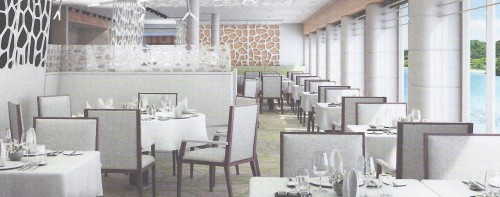
The fitness-area, measuring over 300 square metres consists of the Spa where guests can choose from the steam bath, Finnish sauna and the outside pool where they can swim against the current this pool features. It can be closed in inclement weather as it has a tent-roof acting as a retractable magrodome. Hanseatic- expeditions are all about enrichment and the experience of travelling to remote places, so no entertainment like rock-climbing, zip-lines and the like are to be found on board.

Instead there are lectures given by 16 experts and scientists who of course also accompany guests during excursions. Lectures take place in the Hanseatic Atrium on deck 4 which is a multi-functional lounge equipped with large LED-screens and panoramic windows which is used as a bar at night (there are even juke-boxes to enliven the mood).


The Ocean Academy, another lecturing-hall features a 6 x 1.8 metre touch screen wall, the Study Wall, enabling passengers to access info about the ship’s destinations and there are microscopes, exhibits and relex-chairs with built in screens. Speaking of screens: screens showing footage of remote places the ship will head to are also present in the central lobby, behind the guest services desk.


Each vessel costs 160 million US dollar to build and the end result will be a trio of luxury and environmentally friendly expedition ships of the high standard we are used to from HPAG-Lloyd. The luxury aspect can be traced to the guest staterooms and suites. These all have a heated bathroom wall so wet clothes can be dried easily after returning from excursions. Nordic-walking sticks and even Swarovski-manufactured binoculars are standard too. On the outside decks , which are 50% larger than those of the previous Hanseatic, on deck 8 there are two retractable glass bottom balconies making it possible for guests to look down along the ships sides.

At the bows, a spot normally out of bounds for passengers a promenade the “Nature Walk” (“Inspiration Walk” on the Hanseatic Inspiration) offers great views. Enjoying the scenery from the Observatory Lounge high on the ship on deck is another option.The fold-out marina at the stern is where the 17 zodiacs and available kajaks are launched, being the starting point of many excursions. The Hanseatic series vessels have a radius of 8,ooo miles or 36 days, which is about twice a “regular” expedition cruise ship can do and they can sail in regions with temperatures between +40 and –25 degrees Celsius. Pure low Sulphur marine diesel is used for fuel. Alas, LNG was not possible as it just is not available in the remote regions these ships cruise. Of course all waste fluids are kept on board and are disposed of in port. The use of SRC-catalysts cleaning exhaust gasses reduces CO-emissions over 90% as well as the specifically designed hulls and their Rolls-Royce PROMAS-propulsion which is a propulsion system where the propeller and the rudder are integrated to optimise hydrodynamic efficiency. Finally, environmentally friendly biological lubricants are used for the stabilizers and bow thrusters.

The second ship of this series, Hanseatic Inspiration was named on October 11 2019 in Hamburg during a spectacular ceremony. Guests and HAPAG-staff while being on board 27 zodiacs and 3 barges watched high-output beamers use the ships side as a movie screen as footage of the destinations planned for the Hanseatic Inspiration to visit was projected. Then a pontoon approached with HAPAG-Lloyd Cruises CEO Karl Pojer, Captain Ulf Wolster and godmother Laura Dekker (known for her single handed circumnavigation of the globe on board her sailing ship at the age of 14) who named Hanseatic Inspiration and following tradition let the botlle of champagne smash against her bow.
Guests are always welcome on the bridge to meet the officers on duty and watch them navigate the ship as there is an open-bridge policy, except when the ship is manoeuvering in port or sailing in congested waters of course. 138 camers spread all over the ship enable officers to keep a close watch over the entire ship.
It is obvious Hapag-Lloyd is raising the bar again for competing expedition cruise vessels with this new trio of expedition cruise ships. Not only because of the impeccable service, gourmet food and luxury interiors of their vessels, but also considering the environmental measures that were taken and the extreme distances they can cover guaranteeing spectacular itineraries as well!
Deck-plan Hanseatic-series expedition vessels

